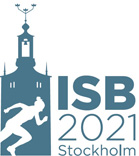TUTORIALS
On Sunday, July 25, we offer 4 different tutorials. Each tutorial costs SEK 450 ex. VAT
You register for the Tutorials together with your Congress registration
If you have registered without choosing turorials, you can email us at isb2021@meetx.se and we will add these to your booking.
The Tutorials will not be broadcast via the OnAIR platform used for the ISB Congress, they will be broadcast via Zoom webinar. All participants registered will receive a personal link a few days before July 25.
To view the recorded Tutorials click the buttons below and enter the password received by email (only available for registered participants)
09:30 – 11:30 To wear or not to wear? Translating Movement Analysis Beyond the Laboratory with Wearable Sensors– Tutors (Andrea Cereatti, Silvia Del Din, Kamiar Aminian)
Low-cost wearable sensors are revolutionizing the world of human movement analysis by enabling to step out of the laboratory and gather a more accurate insight of the way a person performs in real-world conditions. However, to translate research methodologies into clinical practice and to maximize their impact on sports applications, compliance with technical and clinical validity and usability standards must be demonstrated. In this tutorial, we will discuss good-practice guidelines for the best use of measurement units along with an overview of the latest applications in sport performance optimization and challenges for clinical applications in the real world. To stimulate active involvement and follow-up, selected data samples will be presented and made available to the participants as an opportunity to test methods and develop innovative ideas under the supervision of the tutors. The tutorial will also include Q&A sessions with live polling.
12:00 – 14:00 From imaging to modelling: Tips and tricks – Tutors (John Hutchinson, Taylor Dick, Suzanne Cox, and Jonas Rubenson)
This tutorial will walk through one workflow for creating musculoskeletal models “from scratch” using existing 3D image data (polygonal meshes). You will learn how to create skeletal anatomical coordinate systems more objectively for establishing joint axes, to semi-automatically place 3D muscle paths relative to these joints, estimate muscle model parameters and body segment inertial properties, and then exporting complete model files created by this process. Finally, the influence of such parameters on the simulation results will be showcased and discussed. OpenSim software will be used in this tutorial, and sample files will be provided.
14:30 – 16:30 Deep learning applications in biomechanics – Tutors (Neil Cronin, Eni Halilaj)
Machine and Deep learning techniques continue to grow in popularity, and have recently found several applications in biomechanics. In this workshop, we will give an overview of the use of deep learning for time series data, as well as the use of computer vision for automated video analysis. The workshop will include hands-on examples using real-world data.
17:00 – 19:00 Optimal control in biomechanics – Tutors (Friedl De Groote, Gil Serrancoli, Antoine Falisse)
Simulations of movement typically rely on the assumption that humans or other animals move in a way that optimizes performance. As a result, simulations of movement can be formulated as optimal control problems. Solving these optimal control problems is challenging for unstable movements such as human walking. In this workshop, we will give an introduction to recent computational advances that have improved the convergence and efficiency of optimal control problems to simulate movement, guide participants through a hands-on example, and provide guidelines for performing simulations of movement.

